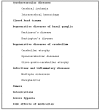Rehabilitation of impaired speech function (dysarthria, dysglossia)
- PMID: 22073063
- PMCID: PMC3201013
Rehabilitation of impaired speech function (dysarthria, dysglossia)
Abstract
Speech disorders can result (1) from sensorimotor impairments of articulatory movements = dysarthria, or (2) from structural changes of the speech organs, in adults particularly after surgical and radiochemical treatment of tumors = dysglossia. The decrease of intelligibility, a reduced vocal stamina, the stigmatization of a conspicuous voice and manner of speech, the reduction of emotional expressivity all mean greatly diminished quality of life, restricted career opportunities and diminished social contacts. Intensive therapy based on the pathophysiological facts is absolutely essential: Functional exercise therapy plays a central role; according to symptoms and their progression it can be complemented with prosthetic and surgical approaches. In severe cases communicational aids have to be used. All rehabilitation measures have to take account of frequently associated disorders of body motor control and/or impairment of cognition and behaviour.
Keywords: dysarthria; dysglossia; functional therapy; prosthetics; speech disorders.
Figures





References
-
- Ziegler W. Grundlagen der Dysarthrien. In: Ziegler W, Vogel M, Schröter-Morasch H, Gröne B, editors. Dysarthrie. 2. Auflage. Stuttgart: Thieme; 2002.
-
- Schröter-Morasch H, Ziegler W. Dysarthrien und Sprechapraxie. In: Wendler J, Seidner W, Kittel G, Eysholdt U, editors. Lehrbuch der Phoniatrie und Pädaudiologie. 3. Auflage. Stuttgart: Thieme; 1996. p. 250.
-
- Schröter-Morasch H, Hoole Ph. Differentialdiagnose hyperkinetischer Bewegungsstörungen des Kehlkopfs. In: Gross M, editor. Aktuelle phoniatrisch-pädaudiologische Aspekte 1997/98, Bd 5. Heidelberg: Median Verlag; 1998. p. 197.
-
- Böhme G. Sprach-, Sprech-, Stimm- und Schluckstörungen. Band 1: Klinik. 4. Auflage. München, Jena: Urban und Fischer; 2003. p. 109.
-
- Leonard R, et al. Differentiation of speakers with glossectomies by acustics and perceptual measures. Am J of Speech-Language-Pathology. 1992;4:56–63.
LinkOut - more resources
Full Text Sources
